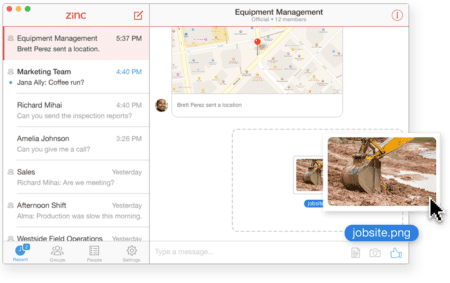When service technicians from Vivint Smart Home, the Utah-based tech company that installs home automation equipment like video-enabled doorbells and smart thermostats for customers across the U.S., are out in the field and need to talk to each other, they don’t send a text or fire up the mobile version of messaging app Slack. Instead, they open up Zinc on their smartphones to request additional tools and help from fellow technicians geographically close to them.
“It’s like a consumer app on steroids. But it also has all the security and control that enterprises need to deploy,” says Zinc CEO Stacey Epstein.
New Name, New Strategy
Founded as Cotap in 2013 by Jim Patterson and Zack Parker, two alumni of enterprise social networking service Yammer, the San Francisco-based startup has made some big changes of late. In the beginning of June, the company relaunched as Zinc, a name change that coincides with a shift in sales strategy from a freemium model to a free trial plan. It also hired Epstein as CEO to shepherd the company’s new go-to-market strategy.
The only screen [service technicians] ever look at is their phone or tablet, but trying to deploy a solution that’s been built for desktop employees to mobile just doesn’t work. It’s not the right interface. — Stacey Epstein

Stacey Epstein
For Epstein, whose background is in marketing — as chief marketing officer for ServiceMax, she helped launch the publication you’re currently reading — stepping into the CEO role is a change of pace. But what Zinc needs now is a whole new way of selling itself to a market saturated with other messaging apps.
“Cotap basically was a texting app for businesses and the go-to-market strategy was a freemium model … but the better go-to-market strategy is a direct paid selling model targeting larger enterprises,” she says. “It’s a complete shift in strategy, which is the reason I came on board.”
Fit for the Field
Messaging apps like Yammer and Slack are not new concepts, but they’re more often employed for desktop workers: people who will be in front of a computer most of the day and need a quick way to talk to their teams. Field technicians, on the other hand, need a specialized app to bridge what Epstein calls the “deskless divide.”
“The only screen they ever look at is their phone or tablet, but trying to deploy a solution that’s been built for desktop employees to mobile just doesn’t work. It’s not the right interface,” Epstein says.
She argues that the right interface is Zinc: “It’s the mobile-first interface that deskless workers like field service technicians need with lots of bells and whistles: audio, video, group calling, location sharing, file sharing.”
Functionality on the Fly
 For Vivint’s field service techs, that functionality on the fly is key, not to mention an easy way for techs to inform corporate what buyers think of Vivint’s smart home tech.
For Vivint’s field service techs, that functionality on the fly is key, not to mention an easy way for techs to inform corporate what buyers think of Vivint’s smart home tech.
For Zinc, which also raised $5 million in Series A funding last month to bring its total venture capital funding to $15.5 million, that functionality is what it will highlight as it moves existing customers from freemium to a free trial model and seeks to add to its already 10,000-strong client list. It’s a challenge Epstein is eagerly embracing.
“It’s a great product with a big market opportunity, and it’s a little bit outside the Silicon Valley bubble of building technology and then selling it to technology workers,” she says, emphasizing that field technicians are often overlooked. “I love the departure from that kind of Silicon Valley.”
Image via Zinc


Share this: